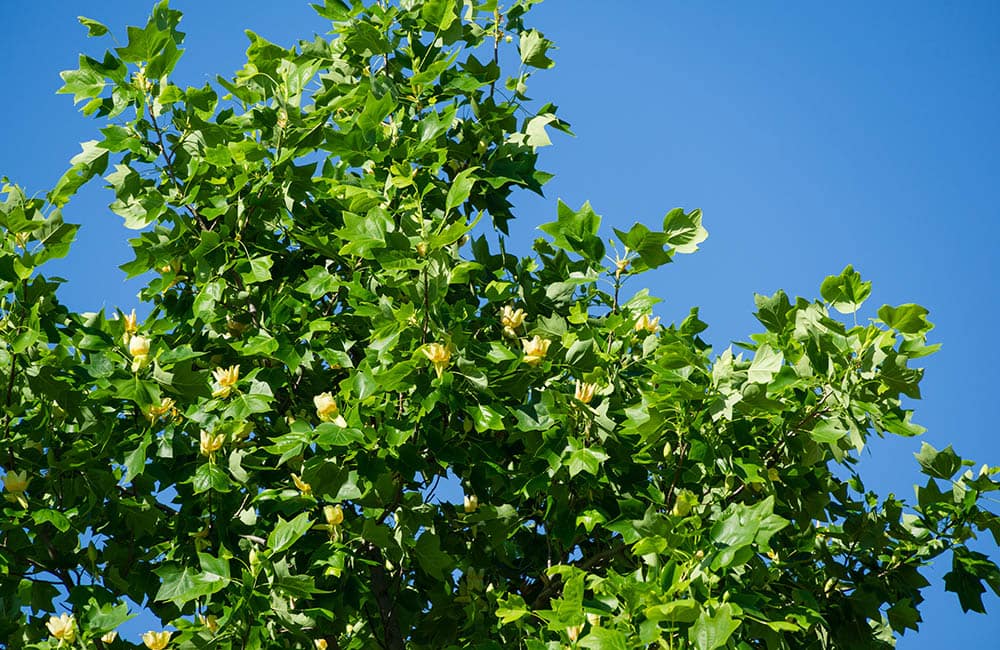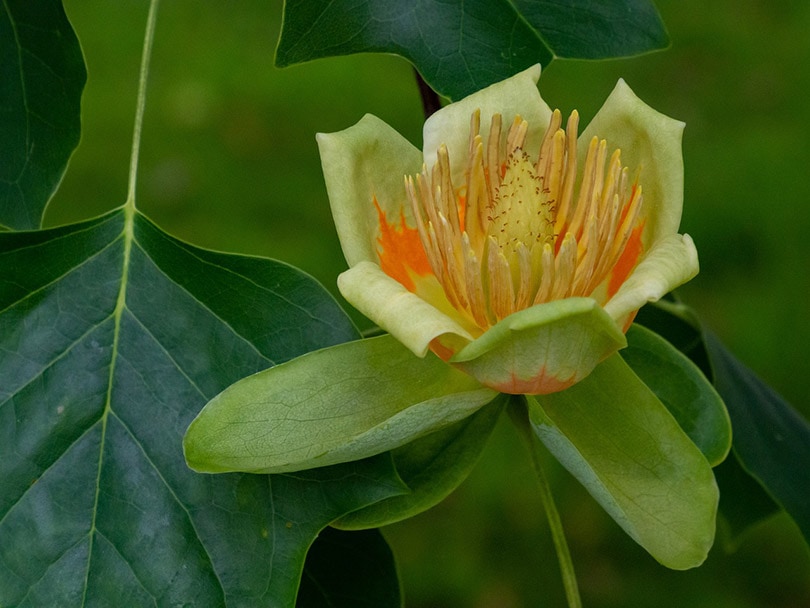What Is the State Tree of Kentucky? History, Facts & FAQ
-
Greg Iacono
- Last updated:

Few state symbols in the United States have had as much controversy as Kentucky’s State tree. It started in 1956 when, after long and strenuous arguments from those who favored the Sycamore tree and others who favored the Indian Cigar tree, the General Assembly in Kentucky named the Tulip Poplar the State’s official tree. Twenty years later, Kentucky’s Senate voted the Tulip Poplar out and the Kentucky Coffee Tree in as the state’s new tree.
Was that the end of the story? No, it was not. Another 18 years passed, but proponents of the Tulip Poplar would not be denied. In March of 1994, Kentucky’s Senate and House of Representatives approved House Bill #128, and Kentucky’s official State tree was once again the Tulip Poplar (much to the chagrin of their Governor Brereton Jones, who didn’t sign the bill). The Tulip Poplar (Liriodendron tulipifera) remains the tree of favor in Kentucky today.
What Does the Kentucky State Tree Look Like?
The Tulip Poplar is an incredibly tall tree and one of the tallest hardwoods native to the United States. During May and June of each year, the Tulip Poplar is strikingly beautiful, with orange and green blooms that give the tree its name. Although the blooms turn into green leaves like most hardwood trees, they become a golden yellow as fall approaches, making them gorgeous yet again. The Tulip Poplar’s samaras (winged, iridescent fruit) have a tight spiral when new and open up gracefully when ripe.
The leaves on the Tulip Poplar have a unique shape and appear rotund at first glance with four lobes. Like the tree itself, the leaves are large, usually between 3 to 8 inches (7.5 to 20 centimeters), long and wide. Tulip Poplars are primarily seen in deciduous forests and have relatively straight trunks that branch into many large branches.
Considering the Tulip Poplar can reach heights of up to 90 feet (27.5 meters) and a spread that can reach 50 feet (15 meters), it’s not surprising that its canopy is among the highest in most forests. Like many hardwoods, the Tulip Poplar’s bark is furrowed and separated into scales and plates.

What Are the Best Growing Conditions for a Tulip Poplar?
The Tulip Poplar needs at least 6 hours of full, unfiltered sun each day to stay healthy. They like loamy, moist soil that drains well and is relatively sandy. Although they like normal moisture conditions found in deciduous forests, the Tulip Poplar can withstand short periods of drought if necessary. They grow best in hardiness zones 4 through 9, covering most of the United States. That also covers the majority of eastern Europe, from Denmark to Spain, Italy, and Greece.
It’s essential you work the soil well before planting a Tulip Poplar since they have fleshy roots that stay relatively close to the tree’s base. They also like slightly acidic soil and, as one of the biggest hardwood trees in North America, need ample space in any yard to grow and spread their beautiful limbs.
Young Tulip Poplars should be staked so they grow nice and straight. They also require regular pruning since they grow incredibly fast. A horticultural spray is necessary to prevent your Tulip Poplars from falling prey to poplar weevils. Unfortunately, they are also plagued by several canker diseases, and if yours is also, a strong fungicide will be necessary to ensure it stays healthy.
Can You Tap a Tulip Poplar Tree?
Like most Poplar varieties, it is possible to tap a Tulip Poplar tree. The best time is early spring when it’s busy producing the most sap. Once tapped, you should be able to collect sap for 3 to 5 weeks, which is best done in the late afternoon after the tree has been warmed by the sun.
The ideal place to make the tap hole is about 3 feet (1 meter) above the ground and on the sunniest side of the tree. The tap hole should be about 2 inches deep. Be sure to use the drill to remove excess wood from the hole before you finish and hammer in the tap. The Tulip Poplar makes enough sap that you can use a 5-gallon bucket to catch it, which you should empty daily to prevent bugs from entering and making a mess.

Is Tulip Poplar Wood Valuable?
Tulip Poplar wood is prized and valuable for several reasons. First, its trunk can grow almost 90 feet without additional, large limbs, which is perfect for making long beams. Also, compared to many fast-growing tree species, the Tulip Poplar has a long lifespan and has strong wood. It is also flood-tolerant, and adult trees will survive the occasional flooding with few problems.
Fun Facts about the Tulip Poplar
- Native Americans called the Tulip poplar the “canoe tree” because of its long, wide, straight trunk. They were perfect for making dugout canoes.
- The Tulip Poplar isn’t a Poplar at all but instead a Liriodendron.
- Bees are especially attracted to Tulip Poplars because their flowers make a lot of delicious sap.
- The inner bark of the Tulip Poplar’s roots is used to make a medicine called Hydrochlorate of tulipiferene, which is used to stimulate the heart in times of a cardiac crisis.
- Tulip Poplar wood is used to make a wide variety of objects, including flooring, paper, and furniture. It’s also widely used in construction and for making laminate.
- Early American settlers sent Tulip Poplar saplings back to Europe in the 1700s, and, today, they are one of the most prolific trees grown in both the United Kingdom and France.
- The nectar from the Tulip Poplar is used to make gourmet honey.
- Tulip Poplars have been said to have trunks that can reach 16 feet (4.8 meters) in diameter.
- Although classified as a “hardwood,” the Tulip Poplar actually has soft wood that’s relatively easy to cut, whittle, and work.
- A Tulip Poplar can grow up to 24 inches (61 centimeters) in a single season.
- Tulip Poplars are the most popular host tree for swallowtail butterflies.
- While the Tulip Poplar blossoms, you can drink its honey-flavored nectar straight from the flower. It’s rather thick so take your time when enjoying it.
- Tulip Poplar wood is also known as yellow poplar, tulipwood, canoe wood, and whitewood.
- The bark of the Tulip Poplar was once boiled and used to make a medicinal tea to treat malaria and typhoid. Early settlers also boiled it down even further to make a cough syrup.
- The oldest living Tulip Poplar in the United States is located in the New York City borough of Queens and is named the Queens Giant. This amazing tree is thought to be between 350 and 450 years old. The Queens Giant was 134 feet (41 meters) tall when it was last measured.
- Beekeepers love the Tulip Poplar because it makes so much nectar, which is essential for their bees to make honey.
- It takes between 10 to 15 years for a Tulip Poplar to bloom for the first time.
- Along with Kentucky, Indiana and Tennessee have adopted the Tulip Poplar as their state tree.
- The raw, green bark of the Tulip Poplar is believed to be an aphrodisiac when chewed.
- Tulip Poplar wood is a favorite of organ makers because it is durable and lightweight. It’s purported to be as easy to work with as pine and similar, softer woods.
Conclusion
We think you’ll agree that Kentucky was right to name the Tulip Poplar as their State tree (albeit with more than a little fuss). The long-living species produces sap that helps bees and durable wood to make various valuable objects. You can find them all over North America and Europe, and the Tulip Poplar’s wood is prized throughout both continents. We hope you enjoyed our in-depth look at this amazing tree and that you now have a deeper knowledge of its important place in human society. One thing is certain: the Tulip Poplar is an incredible, beautiful tree with many fascinating and valuable properties.
- You might also like: Photoelectric vs. Ionization: Types of Smoke Detectors Explained
- https://www.ereferencedesk.com/resources/state-tree/kentucky.html
- https://statesymbolsusa.org/symbol-official-item/kentucky/state-tree/tulip-poplar
- https://www.uky.edu/hort/Tulip-Poplar#:~:text
- https://www.arborday.org/trees/treeguide/treedetail.cfm?itemID=930
- https://www.gardeningknowhow.com/ornamental/trees/tulip-tree/growing-tulip-trees.htm#:
- https://www.woodmagazine.com/wood-supplies/wood-species/what%27s-the-difference-between-yellow-poplar-and-tulip-poplar
- https://owlcation.com/stem/Tulip-Poplar-Tree-Facts-Uses-and-Planting-Tips
- https://www.virtualblueridge.com/nature/tulip-poplar/
Featured Image Credit: Marinodenisenko, Shutterstock
Contents
